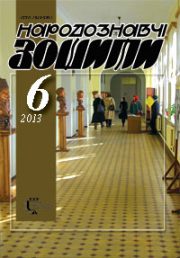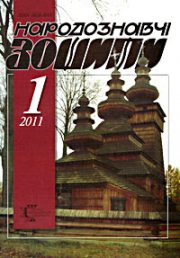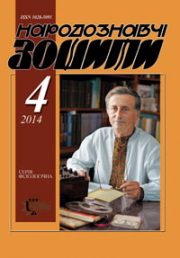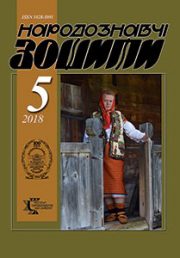The Ethnology Notebooks. 2022. № 1 (163), 162—175
UDK [392.81:398.332.416]:930.2](477.81/.82)
DOI https://doi.org/10.15407/nz2022.01.162
KUTIA AND KOLYVO: COMPARATIVE ANALYSIS OF RITUAL DISHES (ON MATERIALS FROM WESTERN POLISSYA)
SYMKO Victorya
- ORCID ID: http://orcid.org/0000-0003-0823-5245
- Student, Scholarship holder of academic scholarships
- of the President of Ukraine 2021/22
- a member of The Small Academy of Sciences,
- Ivan Franko Lviv National University, Faculty of History,
- 1, Universytetska Str., 79000, Lviv, Ukraine,
- Contacts: e-mail: victoryasymko@gmail.com
Abstract. The folk culture of Ukrainians is an issue that has inexhaustible relevance, because its importance is in preserving the Ukrainian identity in a globalized world, in explaining the historical sources of cultural phenomena. It should be noted that each topic from different areas of Ukrainian folk culture is relevant. After all, the local specificity of cultural phenomena in certain areas causes difficulty in reproducing their full picture. In this context, we emphasize the importance of collecting field materials — on interview recordings from respondents — bearers of traditions.
The purpose of the study is a comprehensive description and comparative analysis of kutia and kolyvo as ritual dishes presented in the traditional culture of Ukrainians in Western Polissya. The object of study — ritual dishes kutia and kolyvo in the folk culture of Ukrainians, and the subject — common and different in these dishes in terms of folk names, cooking, consumption, use in customs and rituals in Western Polissya.
Research methods. At the time of writing the articlethe principle of historicism was followed and general scientific and special scientific methods were applied. Among them, special attention is paid to the methods of field ethnographic research, in particular, interviewing respondents (in the conditions of quarantine, telephone interviewing was used), as well as such methods as comparative-historical, typological, structural and functional.
As a result of the research, materials from Western Polissya show that kutia and kolyvo have a clear connection, which can be traced in the household and ritual spheres. It was found that the basis of the two dishes was sweetened (honey, sugar) porridge, mainly from wheat or barley, and later also from rice. Instead, poppy seeds were added to the kutia, in some places — uzvar, nuts, raisins, oil, milk and cracklings (for a meal on January 13). It is shown that kutia and kolyvo were usually the first during ritual meals, they were tasted on three spoons, and the remains were most often fed to chickens or birds. It is investigated that in the rites of winter holidays, in which kutia appears, there are economic and funeral (kutia as food for the souls of deceased relatives) motives. Kolyvo, according to Polishchuks, is exactly the food for the souls of the dead, and as porridge appears in actions with economic motives.
Keywords: kutia, kolyvo, Ukrainians, Western Polissya, northern districts of Volyn region, Christmas, New Year and Epiphany rites, funeral and memorial rites.
Received 17.01.2022
REFERENCES
- Chubynskyi, P. (1872). Proceedings of the ethnographic and statistical expedition to the West-Russian Land, equipped by the Imperial Russian Geographic Society. South-West department. Materials and research (Vol. III: People’s diary). St. Petersburg: V. Bezobrazov and Comp. Printing House [in Russian].
- Chubynskyi, P. (1877). Proceedings of the ethnographic and statistical expedition to the West-Russian Land, equipped by the Imperial Russian Geographic Society. South-West department. Materials and research (Vol. IV: Homeland rites: christening, wedding, funeral). St. Petersburg: V. Kirshbaum’s Printing House [in Russian].
- Domanytskyi, V. (1912). Folk calendar in Rivne district, Volyn province. Materials on Ukrainian ethnology, 15, 62—89 [in Ukrainian].
- Hlushko, M. (2011). Who had recorded «Narodny calendar u Rovenskim poviti Volynskoyi huberniyi» The Ethnology Notebooks, 1, 28—42 [in Ukrainian].
- Halaichuk, V. (2019). Popular calendar of Bereznivshchyna in rituals, customs and folklore. The Ethnology Notebooks, 4, 951—1000 [in Ukrainian].
- Halaichuk, V. (2012—2013). National calendar of Zarichnenshchyna in rites, customs and folklore. Proceedings of History Faculty of Lviv University, 13—14, 43—83 [in Ukrainian].
- Halaichuk, V., & Tsypyshev, S. (2020). Popular calendar in rituals, customs and folklore of Liubeshiv district. The Ethnology Notebooks, 6, 1454—1483 [in Ukrainian].
- Tolstaya, S. (2005). Polissyan folk calendar. Moscow: Indrik [in Russian].
- Skrypnyk, H. (Ed.), Taran, O., & Buyskykh, Yu. (2020). Ethnographic image of modern Ukraine. Corpus of expeditionary folklore and ethnographic materials (Vol. 5: Funeral customs and rites). Kyiv: M. Rylsky Institute of Art, Folkloristics and Ethnology Studies of National Academy of Sciences of Ukraine [in Ukrainian].
- Skrypnyk, H. (Ed.), Bondarenko, H., & Kurinna, M. (2016). Ethnographic image of modern Ukraine. Corpus of expeditionary folklore and ethnographic materials (Vol. 6: Calendar rituals). Kyiv: M. Rylsky Institute of Art, Folkloristics and Ethnology Studies of National Academy of Sciences of Ukraine [in Ukrainian].
- Artyukh, L. (1977). Ukrainian folk cooking (Historical and ethnographic research). Kyiv: Naukova dumka [in Ukrainian].
- Artyukh, L. (1994). Kolyvo. Ukrainian past. Illustrated ethnographic guide. 2nd edition. Kyiv: Lybid [in Ukrainian].
- Artyukh, L. (1994). Kutia. Ukrainian past. Illustrated ethnographic guide. 2nd edition. Kyiv: Lybid [in Ukrainian].
- Artyukh, L., & Hrytsenko, P. (Ed.). (1994). Areal characteristics of funeral bread in Ukrainian Polissya. Problems of modern areology (Pp. 318—323). Kyiv [in Ukrainian].
- Konobrodska, V. (2007). Polissya funeral and memorial rites. Ethnolinguistic studies (Vol. I). Zhytomyr: Polissya [in Ukrainian].
- Kurochkin, O. (1999). Calendar customs and rites. Ukrainians: historical and ethnographic monograph: in 2 books. Book 2 (Pp. 297—332). Opishne: Ukrainian Folk Studies [in Ukrainian].
- Ulyanovska, S. (1999). Funeral and memorial rites. Ukrainians: historical and ethnographic monograph: in 2 books. Book 2 (Pp. 333—344). Opishne: Ukrainian Folk Studies [in Ukrainian].
- Valentsova, M., & Tolstoy, N. (Ed.). (2004). Kutia, kolyvo, kanun. Slavic antiquities: ethnolinguistic dictionary (Vol. T. 3).Moscow: International Relations. 69—71 [in Russian].
- Kovalchuk, N. (2010). Modern tendencies of transformation processes in the calendar customary-ritual culture of Polishchuks (according to field ethnographic materials of Rivne Polissya). Materials on Ukrainian ethnology, 9, 312—318 [in Ukrainian].
- Savka, M. (2012). On agricultural motifs of winter ritualism in Volhynia region (after data from Horokhiv region of Volhynia land). The Ethnology Notebooks, 5, 839—844 [in Ukrainian].
- Hilevych, I. (2012). The field ethnographic exploration of Polissya of Ukraine (the second half of ХХ — at the beginning of ХХІ c.): abstract of the dissertation of the candidate of historical sciences: 07.00.05. — ethnology. Lviv: Ivan Franko National Univetsity of Lviv [in Ukrainian].
- Hlushko, M. (2008). Middle Polissya in the system of ethnographic regionalization of Ukraine: localization and borders (based on research works of the second half of the XXth and early XXIth centuries). Visnyk of the Lviv University. Historical Series, 43, 15—33 [in Ukrainian].
- (1989). Kutia. Etymological dictionary of the Ukrainian language. In seven volumes (Vol. 3). Kyiv: Naukova dumka [in Ukrainian].
- Arkushyn, H. (2000). Dictionary of Western Polish dialects. In two volumes (Vol. 1). Lutsk: Vezha [in Ukrainian].
- Konopka, V. (2014). Volhynian people’s calendar (after materials from the villages of Vilhir and Kolesnyky in Hoshcha region of Rivne obl.). The Ethnology Notebooks, 2,392—402 [in Ukrainian].
- (1985). Kolyvo. Etymological dictionary of the Ukrainian language. In seven volumes (Vol. 2).Kyiv: Naukova dumka [in Ukrainian].







